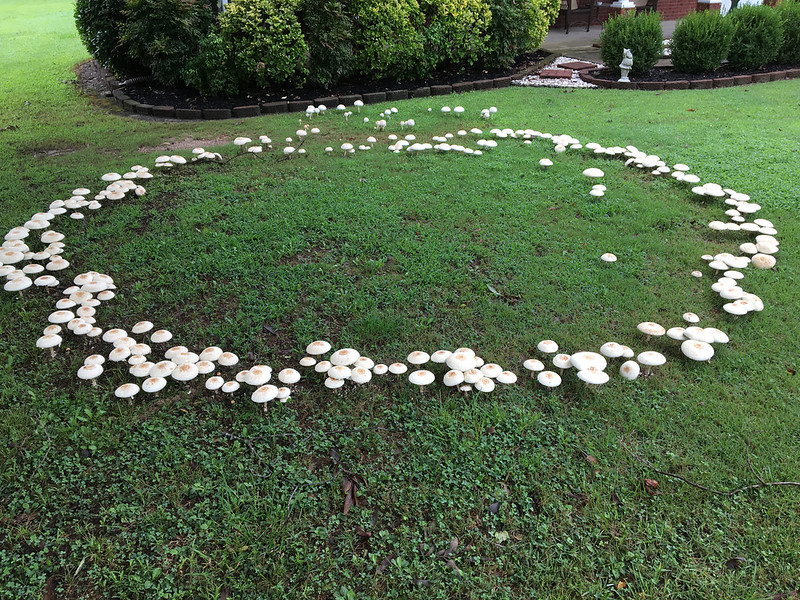Sept. 4, 2020
Fairy rings: Curious product of mushrooms decomposing clippings, debris
By Mary Hightower
U of A System Division of Agriculture
Fast facts
- Fairy rings a function of depletion of decayable material
- Most common fairy ring fungus is toxic false parasol mushroom
(425 words)
(Newsrooms: with additional art at https://flic.kr/s/aHsmQx9xXC )
(Download this story in MS Word format here.)
HOPE, Ark. — Clusters of mushrooms popping up after lots of rain isn’t a surprise, but some Arkansans are currently seeing a particularly charming fungal array commonly known as fairy rings.
Lance Blythe, Greene County extension staff chair for the University of Arkansas System Division of Agriculture, noticed lots of these formations around Paragould on Thursday. Rounds of rain following Tropical Storm Laura during the last week of August have made conditions perfect for fungi to thrive.
“I haven’t gotten any calls about these yet, but I’m sure it’s about to start,” he said Thursday.
Not all of these rings are circular. Blythe found one that was a small circle embedded on the edge of a half circle. Another even looked like the outline of a dog’s head from a certain angle.
Legend vs. biology
“There is a legend that fairy rings are formed in areas where fairies dance. However, there is a more scientific explanation,” said Vic Ford, a fungus expert who is also associate director for agriculture and natural resources for the Cooperative Extension Service.
“Fairy rings are formed from the growing of the mycelium of mushrooms in grass,” he said. “The mycelium is the vegetative part of the mushroom and causes grass clippings and debris to decay.
“During the decay process, plant mineral nutrients are released that fertilize the grass, creating the darker green appearance,” he said. “Also, plant growth hormones stimulate the grass growth. The fairy rings associated with grass in lawns, meadows, and golf courses are called free fairy rings. They form when a single spore gets established in the grass and begins to grow.”
As decayable material for the mycelium is depleted in the center, the ring expands further away from the center” enlarging the ring, Ford said.
“These rings can be centuries old, with a fairy ring in France being documented over 700 years old,” he said.
The most common free fairy ring in Arkansas is formed by the fungus, Chlorophyllum molybdites. Commonly known as the false parasol mushroom, it has green spores and is known as a “vomiter.”
“It is definitely toxic to people and pets,” Ford said.
“Tethered fairy rings” are associated with trees, he said. These occur when mushroom mycelia are growing symbiotically with the tree roots. As the tree roots expand, the mycelia follow the expanding roots. There are many common mushrooms and associated fungi the for this symbiotic relationship with trees.
Ford said, “Enjoy the beauty of fairy rings but watch for the ‘fae’ folk.”
Find the fact sheet, “Fairy Ring of Turfgrass,” https://www.uaex.uada.edu/publications/pdf/FSA-7539.pdf.
To learn about extension and research programs in Arkansas, visit https://uada.edu/
Follow us on Twitter at @AgInArk, @uaex_edu or @ArkAgResearch.
About the Division of Agriculture
The University of Arkansas System Division of Agriculture’s mission is to strengthen agriculture, communities, and families by connecting trusted research to the adoption of best practices. Through the Agricultural Experiment Station and the Cooperative Extension Service, the Division of Agriculture conducts research and extension work within the nation’s historic land grant education system.
The Division of Agriculture is one of 20 entities within the University of Arkansas System. It has offices in all 75 counties in Arkansas and faculty on five system campuses.
Pursuant to 7 CFR § 15.3, the University of Arkansas System Division of Agriculture offers all its Extension and Research programs and services (including employment) without regard to race, color, sex, national origin, religion, age, disability, marital or veteran status, genetic information, sexual preference, pregnancy or any other legally protected status, and is an equal opportunity institution.
# # #
Media Contact: Mary Hightower
Chief Communications Officer
University of Arkansas System Division of Agriculture
mhightower@uada.edu
501-671-2006
